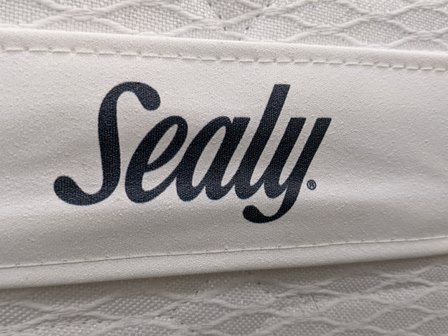The UK mattress market is huge, and it’s hard to know where to start when searching for the best mattress. Here’s our guide to 10 of the best mattresses of 2024 in the UK. It’s ideal for those who are completely flummoxed and don’t fancy reading masses first..
These are the mattresses which have won awards and the best value mattresses from some of the most respected and recommended brands in the bed market. We’ve tried to include a range of prices so there are a few budget mattresses alongside luxury options.
We’ve also included a mix of pocket spring and memory foam mattresses. If you aren’t sure which you want, read our best mattresses beginners guide or the memory foam v pocket springs guide.
Prices are for double mattresses, without a base. Singles and queen size mattresses/small doubles are cheaper. King size mattresses and super king mattresses are more expensive obviously.
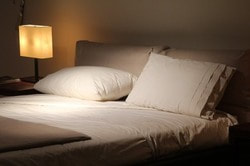
1. Nectar Memory Foam Mattress – £600 – medium/firm
No, this one has nothing to do with the rewards card you use in Sainsburys.
Nectar started out with one mattress – called the Nectar Mattress. The company now makes five mattresses, but this is the original one and it remains a great value mattress. It has been renamed as the Nectar Memory Foam Mattress to distinguish from the other models in the range.
The Nectar Memory Foam Mattress is what’s known as a ‘bed in a box’ mattress which has several layers of foam instead of springs to keep you comfortable. If you prefer a few springs in your mattress then you would be better to look at one of Nectar’s hybrid models, which include Nectar Essential Hybrid Mattress (£), Nectar Hybrid Mattress (££) and the Nectar Premier Hybrid Mattress (£££).
Awards and praise
The Nectar Memory Foam Mattress has won several awards from independent experts and gets good reviews from customers. The Nectar Sleep brand scores 4.2/5 on Trustpilot after 14,000+ reviews. It’s a little confusing as the early reviews only refer to the Nectar Memory Foam Mattress whilst later reviews could be for any of the Nectar Sleep products, which include things like bedding.
This is all very positive, but what makes Nectar Sleep stand out from all the other heavily advertised mattress brands?
Firstly, it comes with a 365 night trial. Most of its rivals offer 60, 100 or 200 nights. That may not make a great difference to you, but there is some advantage to being able to try a mattress during different seasons.
Secondly, it offers what it calls a ‘forever’ warranty (check the Ts & Cs) and say that they’ll guarantee it ‘for as long as you own the mattress’. Most similar mattresses offer a 10 year warranty, whilst posh brand Vispring offer a 30 year warranty. Offering a never ending warranty isn’t something I’ve seen elsewhere, apart from luxury brand DreamCloud (£949 – see #8 on this list).
What about the environment?
There is an argument that foam mattresses are less environmentally friendly than those made with natural materials. A comparison of foam v pocket springs by Lanoë, Simões et al in 2013 concluded that a foam mattress ‘has a higher environmental impact’. The ‘main issue’ is the manufacturing process.
However, Nectar Sleep’s sustainability page says that its ‘mattress production is certifiably climate neutral’. The company says they ‘calculate the carbon footprint from our manufacturing process, find strategies to reduce this, and offset the remainder.’
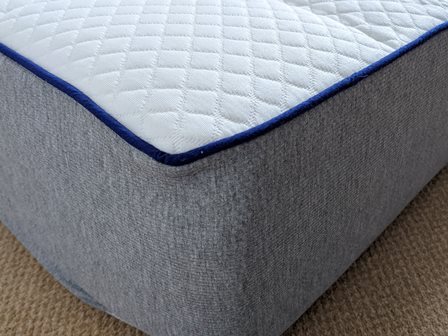
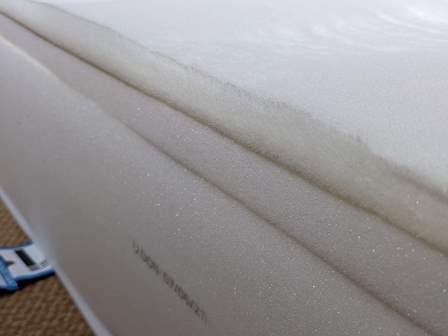
[affcoups id=”3062″]
Upgrades in the Nectar Sleep range
Nectar Sleep also sell a beefed up version of their standard Nectar Sleep Memory Foam mattress.
It’s called the Nectar Premier Mattress and comes with an extra centimetre of memory foam, as well as a different base layer. It gets a bit jargon heavy at this point, but you get ‘Honeycomb micro-zone transition layers’ rather than a ‘7 zone supportive base’.
The gist of it is that the more expensive one aims to accommodate for your curves and bumps better.
Honestly, the differences between the two are quite modest – and they both come with the same trial period so you can always swap it if it doesn’t feel right.
Similarly priced alternatives to the Nectar mattress include:
- The Ergoflex 5G (£581) is medium/firm, which is similar to the Nectar Sleep mattress. It also has a similar depth of memory foam, and comes with a trial period. The trial period is 30 nights and the warranty is 10 years, which are both less generous than the Nectar Sleep. It gets an outstanding score of 4.8/5 on TrustPilot which is higher than Nectar Sleep.
[affcoups id=”3120″]
2. Simba Hybrid Original Mattress – £819 – medium/firm
The Simba Hybrid Original is another multi award-winning mattress which lets you try it out at home for several months. The current trial is 200 nights (mattress historians will note that it has been 100 nights and 365 nights at various times).
It works in a slightly different way to the Nectar Sleep Memory Foam mattress because it has a layer of springs, as well as several layers of foam. The springs are tiny and are designed to add a bit of comfort whilst the foam does most of the heavy lifting (no offence).
According to Simba, it’s won ‘more awards, from more experts’ than any of their rivals. Awards included Ideal Home, Good Housekeeping and Men’s Health in recent years. In 2022, it was named as a finalist in a prestigious bed industry awards which is usually dominated by traditional manufacturers which specialise in pocket springs. It was one of the best online retailers of 2022.
Simba’s customer reviews are glowing. The brand as a whole scores 4.4/5 on TrustPilot whilst this mattress manages 4.8/5 on the Simba website or 3.9/5 on Amazon.
You get a 10 year guarantee, which is certainly impressive but is less than the Nectar Sleep mattresses and is similar to other ‘bed in a box’ mattresses.
On the downside, it’s only available in one firmness which is described as medium-firm by Simba Sleep.
Getting to grips with Simba’s growing range of mattresses
At one stage, Simba just had one mattress and they used the tagline that ‘the perfect mattress didn’t exist, so we invented it’. Over the years, the range has increased so there are now 12 Simba mattresses. This is a good thing if you like the Simba brand and want choice, but it is a big change from the ‘disruptive’ approach of just offering one mattress which is ideal for most people.
The original and best selling model is now known as the Simba Hybrid Original Mattress. It was previously just called the Simba Sleep Mattress or the Simba Hybrid Mattress (I believe that the design has changed a bit, but it’s broadly the same mattress).
Amongst those dozen models in the Simba range, there are posher hybrid models with more springs and thicker layers of foam such as the Simba Hybrid Pro (£££) and Simba Hybrid Luxe (££££). There are also thinner models that just use foam and are much thinner such as the Simbatex Essential Mattress (£). Curiously, Simba also now has an ‘Earth’ range. These use natural materials and large pocket springs that you usually associate with traditional mattress brands like Vispring and Hypnos. Whilst Simba Sleep doesn’t have the established prestige of those two brands, it does offer the major advantage of offering home trial periods with all of its range. That even applies to its pocket spring models. A few years ago, trial periods with pocket sprung mattresses was rarer than hen’s teeth.
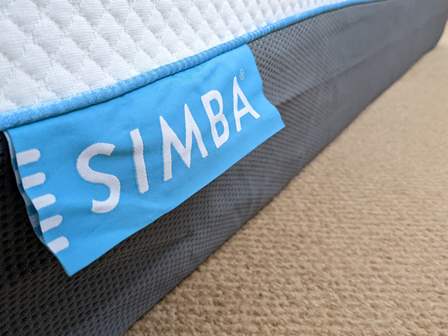
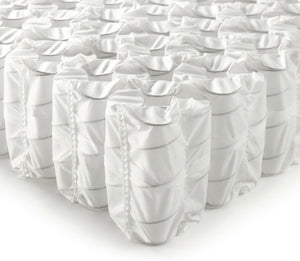
[affcoups id=”3116″]
3. Silentnight Classic 1200 Pocket Deluxe/Sofia – £449 – medium/firm
If you want a traditional style mattress from a brand you’ve heard of then take a look at this good value pocket spring mattress from Silentnight. It’s made using springs, which are what most of us are used to on a mattress. Foam mattresses are the more modern alternative.
Silentnight is the biggest name in beds and mattresses in the UK and this model is a big seller and an award winner. When we checked, it was scoring 9/10 from more than 1000 reviews on Mattress Online. As of 2023, the Silentnight brand scores 4.3/5 on TrustPilot. That makes it one of the highest rated sprung mattress brands.
A well sprung mattress
The 1200 figure in the title tells you the number of pocket springs on the king size version of the mattress. 1000 to 2000 pocket springs is what you get on the majority of good quality sprung mattress. 1200 will be perfectly adequate for you unless you’re very heavy, in which case you might want something like the Silentnight London Stratus 2000.
You can turn this mattress over, which is a good thing as it should reduce the risk of getting lumps and bumps over time.
The Silentnight Classic 1200 Pocket Deluxe goes by a few different names, including the Silentnight Sofia and the Silentnight Walton.
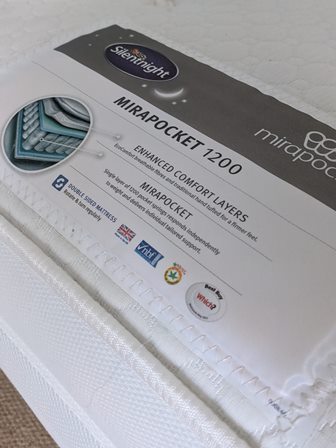
[affcoups id=”3327″]
Similarly priced alternatives to the 1200 Pocket Deluxe include:
- the Sleepeezee Hybrid 2000 (£799) is a firm mattress which won an award from expert testers. The Sleepeezee brand also has a couple of big things going for it. Firstly, it’s got a Royal Warrant. Secondly, it was one of the highest rated pocket sprung brands we could find based on customer reviews on TrustPilot (4.2/5).
- the Silentnight London Stratus 2000 (£607) is a highly rated pocket spring mattress with glowing reviews (8.9/10 at the time of writing). It is medium firmness and has a slightly higher spring count than the 1200 mattress. That is particularly good if you are heavier than average. One downside with this mattress is that you can’t turn it over as it has a thin memory foam layer on top. A non turn mattress is a good thing if you aren’t able to lift it but most people say you’ll get better wear out of a double sided mattress.
- The Silentnight Deluxe Box Top Mirapocket 2000 Limited Edition Mattress (£709) is worth a mention as it is a popular mid-priced soft/medium mattress. We previously recommended the award-winning Sealy Teramo/Nostromo as a soft/medium mattress but it’s been discontinued.
This Silentnight model is a colossal mattress at 39cm deep (you may find your nose touching the ceiling). The massive depth is due to it using a combination of 2000 pocket springs along with an 8cm layer of ‘super soft foam’. 2000 springs is a high specification for a mattress in this price range. The two downsides with this mattress are that it is single sided (due to the topper only being on one side) and it only comes with a 5 year guarantee. The good news is that it is a big seller and is well-reviewed.
4. Happy Beds Majestic 1000 Pocket Sprung Mattress – £259 – medium firmness
Let’s start by saying that you get what you pay for with a mattress – more or less. You won’t get a world-beating pocket spring king size mattress for £259 (or £229 for a double).
However, I wanted to include at least budget choice in this guide to the best mattresses because not everyone can spend £1000 on some luxurious masterpiece. Or perhaps you just want a guest bed for occasional use.
The Happy Beds Majestic 1000 Pocket Sprung Mattress offers a lot for the money, despite the cheap price. For starters, it uses pocket springs. A lot of sprung mattresses around this price use ‘open coil’ springs which aren’t as stable and supportive.
Academics in China found a link between the stability of your mattress and how well you sleep so this is a worthwhile upgrade. (‘The percentage of deep sleep and sleep efficiency were low when subjects slept on mattresses with poor stability’. Shen, Chen et al, 2012).
Are pocket springs the best mattress design?
Pocket springs have also found to be more durable than ‘open coil’ or ‘bonnell’ springs when tested under laboratory conditions. Vlaović, Grbac and Varošanec published a paper on their research in 2010 into this topic. They found that ‘The samples of pocket spring core have justified their status as a durable spring core system because at the end of the testing there was no serious damage’. The worst performing in their study was a ‘bonnell spring core’.
This mattress has 1000 pocket springs which is the minimum I’d say you want and you’ll want more if you are heavy. It is hand tufted which means it looks like it has buttons holding it together.
It’s also got very positive reviews of 4.3/5 from 300+ reviews on Amazon, as of 2023.
An upgrade to consider if you want the best mattress you can afford
If you’re heavier than average then you might be better to pay about £100 extra for the Happy Beds Signature 2000 King Pocket Sprung Organic Mattress. It’s a similar mattress which has more springs so will offer more support. It currently scores 4.2/5 on Amazon.
The Happy Beds brand is certainly at the budget end of the mattress market but it was scoring a respectable 4.2/5 on TrustPilot when we checked in 2023.

[affcoups id=”3270″]
5. Emma Mattress – £487 – medium firmness
The Emma Mattress is worth a mention as it’s won several awards.
It’s also known as the Emma Original and is another of the ‘bed in a box’ mattresses which come with free delivery. You also get a 200 night trial (so you can return it if you don’t like it) and a 10 year guarantee.
Customer reviews on Google average 4.6/5 whilst scores on Amazon are 4.4/5. TrustPilot review scores are at 4.4/5 but that’s for the whole brand rather than just for this mattress.
According to Emma, the mattress is ‘the UK’s most-awarded mattress in 2019’. The Independent, Good Housekeeping and Ideal Home are amongst those giving it a thumbs up.
A clever design
It’s made entirely from foam, but it puts memory foam into the middle of the mattress rather than on top. The idea is that you get the comfy support of memory foam without the problem of it making you feel too hot.
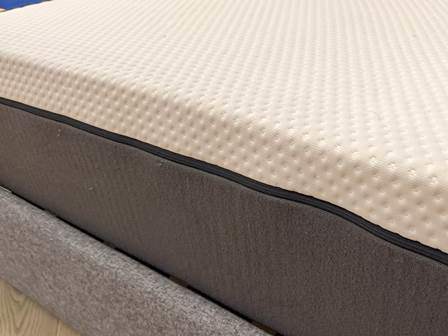
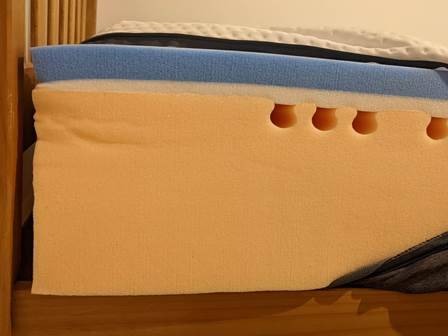
[affcoups id=”3273″]
6. Silentnight 3 Zone Memory Foam – £202 – soft to medium firmness
If you’re looking for a cheap mattress which gets good reviews, I’d take a look at the Silentnight 3 Zone Memory Foam mattress. It is going for £259 in a king size or £189 for a double, at the time of writing. It scores 4.2 out of 5 on Amazon from more than 10,000 reviews, 8.4 out of 10 on Mattress Online and 5/5 on MattressNextDay.
The Silentnight 3 Zone Memory Foam mattress has a 3cm layer of memory foam at the top, with a further 15cm underneath. The best and most expensive memory foam mattresses have a deeper layer of memory foam, as a general rule.
What the reviews say
We can gain some further insight from a keyword analysis of the thousands of reviews written about the Silentnight 3 Zone. We found that praise for the mattress’ value was a repeated phrase amongst the 10,000 reviews. More than 400 reviewers either said it was ‘good value’ or offered ‘value for money’.
On the negative side, about 150 people wrote in their reviews of a ‘chemical smell’. This is quite common with new foam mattresses so my advice is to let it air rather than using it on the first night or two.
Bear in mind that it is made from memory foam which is the most popular alternative to a pocket spring mattress. Memory foam fans point out that they offer consistent support all over. They are usually lighter and longer lasting than a sprung mattress. Memory foam has performed well in some laboratory studies which asked people to try different types of mattress side by side. For example, Hou and Zhang found that younger and older people all preferred memory foam mattresses, apart from older people who slept on their back (2020).
On the down side, lots of people don’t like the unfamiliar quicksand-esque sinking feeling. There is also some evidence that memory foam can make you feel hotter in bed (see data by Chiba, Yabi et al, 2018). Some cheap memory foam also smells for a while, as it is made of less ‘natural’ materials than a good quality sprung mattress.
Is it good for the planet?
Researchers Lanoë, Simões et al (2013) concluded that foam mattresses have ‘a higher environmental impact’ than pocket sprung mattresses. This is mostly due to the manufacturing method. Along similar lines, there is evidence that foam emits higher levels of greenhouse gases than natural materials (Stringer, Glew et al, 2012). It’s worth acknowledging that some companies are taking steps to be carbon neutral.
Lots of people claim that memory foam is better for keeping dust mite allergies away because they aren’t attracted to the artificial material. However, I’d say that theory is still up for debate. A study by Schei, Hessen and Lund in 2002 found far more evidence of dust mites on memory foam mattresses than pocket sprung mattresses.
I should mention that these research papers were carried out on various different mattresses rather than this Silentnight mattress specifically. I’ve mentioned them as they still give some useful insights.

[affcoups id=”3318″]
Similarly priced alternatives to the Silentnight 3 Zone include:
- the Silentnight 7 Zone Memory Foam mattress is a bit thicker and costs about £50 more. The idea of using ‘zones’ on a mattress is to offer different levels of support to different parts of your body. Researchers Leilnahari, Fatouraee et al studied this approach in 2011 on men who sleep on their side. They concluded that ‘Observing the amount of required stiffness obtained for the sleep surface, can have a significant effect on keeping the spine healthy’.
- the Inofia Memory Foam Sprung mattress (£207) is made by a less well-known brand, but reviews were outstanding at 4.7/5 when we checked. It’s 20cm thick and comes with a 100 night trial and 10 year guarantee.
- the Emma Essential mattress (£259) is the budget version of the better-known Emma Original mattress. It’s 18cm thick and was scoring 4.1/5 from customers when we checked. The Emma brand overall scores 4.4/5 on TrustPilot (last checked 2023).
7. DreamCloud Hybrid Mattress – £1649 – medium/firm
The DreamCloud Sleep is worth a look if you like pocket spring mattresses but also want a long home trial period. It’s a substantial mattress at the luxury end of the market, which is a whopping 29cm deep.
It’s one of two mattresses we’ve found which offers a whole year to try it out and a ‘forever’ warranty. However, unlike the Nectar Memory Foam mattress it’s what you call a hybrid mattress as it uses pocket springs with two thin layers of foam on top. Pocket springs are what most us have been sleeping on for our whole lives. The foam layers offer a bit of comfort and consistent support.
One of the layers is memory foam which has a hugging feeling which some people love whilst other people aren’t so keen on. Personally, I like a layer of memory foam on top of a sprung mattress.
As mentioned elsewhere, memory foam can also make you feel warm in bed. Mattresses like this one use ‘breathable memory foam’ to overcome this. Obviously, you have the option of sending it back if it’s not right for you.
The good news about memory foam
A number of studies have been carried out into the pros and cons of memory foam (also known as visco-elastic foam). In one study, researchers compared memory foam mattresses with standard mattresses on people recovering from hip operations in hospitals. They found that ‘patients on standard mattresses tended to develop more severe pressure ulcers’. The implication is that the memory foam mattress did a better job of spreading out weight and pressure (see Gunningberg, Lindholm et al, 2013). That’s a positive, regardless of whether you are in hospital. Too much pressure on any part of your body whilst you sleep isn’t a good thing.
When we checked, DreamCloud was scoring 4.4/5 from customers on TrustPilot which is very decent.
You can’t turn this one over so you just rotate it round to extend its life. The DreamCloud mattress is manufactured in the UK.

[affcoups id=”3329″]
8. Vispring Plymouth Supreme Pocket Sprung Mattress – £1429 – medium tension
Vispring deserve kudos for creating the pocket spring mattress more than a century ago. Pocket springs are now the most popular choice for mattress shoppers in the UK. The company still makes some of the best pocket sprung mattresses around, although you’ll pay a premium for the privilege of owning a Vispring. They were named best mattress brand in 2015, 2016 and 2017 by Which?
Prices for a king size Vispring range from around £1000 – £5000+. I’ve gone for their lowest priced option – the Vispring Plymouth Supreme. You can be confident that if you’re buying a Vispring you’re getting one of the best mattresses on the market (this one comes with a 30 year warranty…). Of course, you will get a better mattress if you pay top prices.
One of the main differences between this mattress and the more expensive Visprings on offer is the spring count, which is about 1200.
The general consensus is that 1000 springs – 2000 springs is the normal range for a quality mattress. Under 1000 isn’t supportive enough, beyond 2000 you don’t see much improvement. Those figures are for a king size mattress, you get higher or lower numbers on bigger and smaller mattresses.
If you are a light person then a number towards the bottom of that range will be adequate. If you are somewhat heavier then you might consider the Vispring Maristow (£3849 for a double mattress, 1700 springs) or Vispring Woolacombe (£4949, 2000 springs).
Signs of quality
The Vispring Plymouth shows off many of the attributes you’d expect from a high quality mattress, besides the spring count. You can turn it over, which means it should last a long time. That assumes you are strong enough to turn it, as high quality mattresses are heavy.
It also has hand side stitching. Don’t worry about the technical details, but it’s a sign that it’s well made.
It is hand tufted which gives it strength and means it looks like it has buttons holding it together on top.
Vispring are also willing to declare which materials they use inside their mattresses, which is a sign of quality. The Plymouth uses wool and cotton. The more expensive ones use pricier materials.
Choosing the right firmness
A medium tension mattress is what people of average height and weight usually go for. Heavier people and people who sleep on their backs or fronts tend to get better support from firmer mattresses. Lighter people get better support from soft mattresses.
It’s generally no longer advised that firm beds are always better for bad backs. The advice now is just to make sure you are well supported which can be achieved by beds of different firmness. See our guide to mattresses for bad backs for more advice on how to choose a mattress.
Vispring mattresses tend to get very good reviews. This one was scoring 4/5 when we checked, albeit from a small number of reviews.
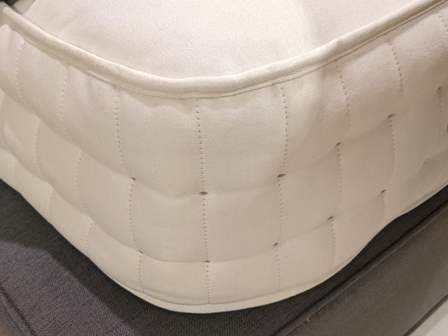
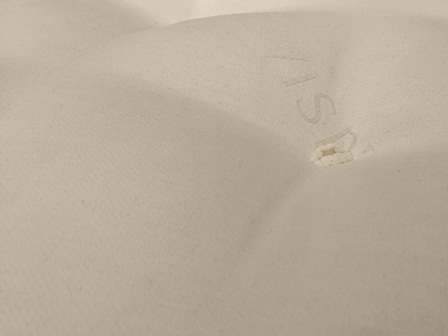
[affcoups id=”3302″]
Similarly priced alternatives to the Vispring Plymouth Supreme include:
- The Sleepeezee Mayfair 3200 pocket sprung mattress (£1099) is a top of the range mattress from one of the highest rated pocket sprung mattress brands on TrustPilot (4.3/5). It has a 60 night ‘comfort trial’ if you buy it from Mattress Online, so you can swap it if you don’t like it. It’s got two layers of springs. The Royal Warrant means they supply King Charles’ household. It is a medium tension mattress. The Sleepeezee brand was a finalist in the category of bed manufacturer of the year at the 2022 bed industry awards.
- John Lewis & Partners Natural Collection 5750 pocket sprung mattress (£1359) is a mid-priced model from the posh John Lewis range. It is made by UK-brand Harrison Spinks which was National Bed Federation manufacturer of the year in 2018 and in 2022. It gets positive customer reviews and is made from luxurious materials. Available in ‘regular’ or firm tensions. We consider ‘regular’ to be the same as ‘medium’. You get a 60-night trial period with this one, though there are some hoops to jump through (e.g. buying a mattress protector at the same time).
9. Hypnos Luxury Wool No. 1 Pocket Sprung Mattress (£1299, medium/firm tension) or No.2 Pocket Sprung Mattress (£1699, medium tension)
Hypnos was the choice of mattress for the royal household of Queen Elizabeth II.
Some Hypnos mattresses will cost you more than £2000 for a double or king size but we’ve picked the much cheaper Hypnos Luxury Wool No. 1 and the Hypnos Luxury Wool No. 2. The Hypnos Luxury Wool No.1 is a medium/firm tension mattress whilst the Hypnos Luxury Wool No.2 is a medium tension mattress. The No.2 model is more expensive because it has an extra layer of wool.
They’re very similar, apart from that.
The spring count is much lower than the more expensive Hypnos beds. However, 1000 pocket springs is adequate if you are a fairly light person and don’t plan to spend every evening eating pies in bed.
They both get terrific user reviews although there aren’t a huge number to go on.
Traditional construction methods
The Hypnos Luxury Wool No.1 and Hypnos Luxury Wool No.2 are what you would consider a ‘classic’ style of bed. They’ve both got many of the signs of quality you’d expect from the Hypnos brand. For example, they’ve both got a ‘tufted top’ which means it looks like buttons are holding them together. They’ve also got a cotton and capok covers which are nice quality materials for a mattress cover. Unfortunately, you can’t turn them over to help extend their lives, so you just rotate them regularly to avoid dips and sags.
As mentioned earlier, the Hypnos Luxury Wool No. 2 is a medium tension bed whilst the Hypnos Luxury Wool No. 1 is a medium/firm bed. According to the Hypnos website, their medium/firm mattresses are best for people ‘who naturally sleep on their back’. If you move around a lot in bed rather than spending most of your time on your back then medium may be better for you (Luxury Wool No. 2)
Hypnos won manufacturer of the year in 2014 and 2017. It was runner up in 2018 at the National Bed Federation Awards, which is the main industry awards. In 2021, it won award at the Bed Show for its sustainability which is industry leading. Furniture News said that Hypnos demonstrated ‘activity and progress on all the award’s criteria – product design, procurement, process improvement, packaging, transport, waste and energy, end of life, employee and customer engagement and corporate social responsibility’.
The springs v foam argument in the best mattress UK debate
There remains furious debate over whether a sprung mattress (such as this Hypnos model) or a foam mattress offers better support and stability. However, I will throw in a mention of research by Park, Subramaniyam et al from 2014. They did a side by side test of a sprung mattress and a foam mattress made by Tempur, which is a posh £2000+ brand. Their investigations suggested that the ‘Spring mattress provided significantly greater relaxation’. They also found there was ‘significantly lower muscle activities when the subject tossed and turned to their right on the spring mattress than (the) Tempur mattress’.
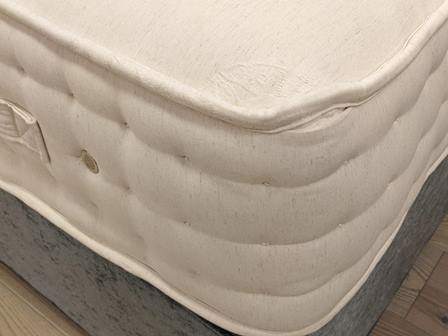
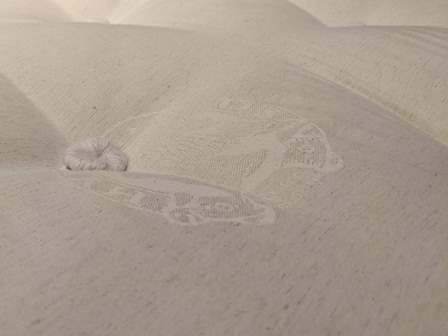
[affcoups id=”3520″]
[affcoups id=”3312″]
10. Brook + Wilde Sleep Lux Mattress – £1299 – medium
Brook + Wilde Sleep’s Lux Mattress has changed a bit since we last updated this guide. Up until 2022, you could pick from soft, medium, firm or extra firm versions of the Lux Mattress. Now, it only comes as a medium mattress. My hunch is that Brook + Wilde Sleep found that this was the best firmness level for most of their customers.
The company do still offer mattresses in a range of firmness levels, but they are the more expensive and luxurious models. Take a look at the Brook + Wilde Sleep Elite Mattress if you think you would rather have a firm or soft mattress. The general rule is that heavier people and people who sleep on their back or front need firmer mattresses so they don’t sink in too much. Lighter people and side sleepers usually need softer mattresses to keep their spine in a good sleeping position.
The Lux Mattress has also won awards and has been called a best buy by expert testers such as Good Housekeeping.
Hybrid technology
The Lux is what’s known as a ‘hybrid’ mattress, meaning it uses layers of springs and foam together (unlike the Nectar Sleep Memory Foam mattress which is all foam). The springs are ‘pocket springs’, which are the best type of mattress spring and are what most of us sleep on. The foam on top is ‘cooling’ memory foam which many experts reckon offers more consistent back support than springs on their own.
You can only buy The Lux Mattress online but you’ve got 200 nights to try it at home and decide if it’s right for you. Check the FAQ for how this works.
It arrives squashed up in a box and expands at home, so it’s a bit easier to get it up the stairs than a conventional mattress. It’s 28cm deep which is a good sign, as most decent mattresses are about 25cm – 30cm deep. It comes with a 10 year guarantee and is made by a UK company.
An important addition
Brook + Wilde Sleep scores 3.2/5 on TrustPilot, which is much lower than it previously scored. A lot of more recent reviews refer to the fact that the company ‘Brook + Wilde’ closed down in 2023. More recently, a new company called ‘Brook + Wilde Sleep’ started up offering the same range of mattresses. The issue mentioned in the recent negative reviews is that the 10 year warranty is not valid if you previously purchased it from ‘Brook + Wilde’ rather than ‘Brook + Wilde Sleep’.
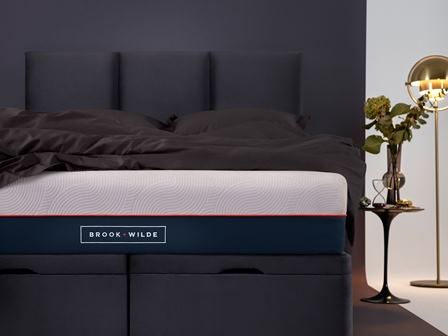
[affcoups id=”3297″]
Which is the best mattress? Our top 10 mattresses side to side on price, firmness and ratings
| Mattress name | What’s it made of? | How firm is it? | TrustPilot brand rating and price (double) | Warranty and trial period |
| Nectar Memory Foam Mattress | Memory foam and other foams | Medium/firm | 4.4/5, £480 | ‘Forever’, 365 nights |
| Simba Hybrid Original | Memory foam and mini springs | Medium/firm | 4.4/5, £647 | 10 years, 100 nights |
| Silentnight Classic 1200 | 1200 pocket springs, eco fibres | Medium/firm | 4.2/5, £449 | 5 years, no trial period |
| Emma Original | Memory foam and other foam layers | Medium | 4.4/5, £487 | 10 years, 200 night trial |
| Happy Beds Majestic 1000 | 1000 pocket springs | Medium | 4.2/5, £259 | 5 years, no trial period |
| Silentnight 3 Zone | 3cm memory foam layer, other foams | Soft/medium | 4.1/5, £202 | 5 years, no trial period |
| Dreamcloud Hybrid | Pocket springs and memory foam | Medium/firm | 4.4/5, £1649 | ‘Forever’, 365 nights |
| Vispring Plymouth Supreme | 1200 pocket springs, wool and cotton | Medium | 3.9/5, £1429 | 30 years, no trial period |
| Hypnos Luxury Wool No 1 | 1000 pocket springs, wool | Medium/Firm | 4.5/5, £1299 | 10 years, no trial period |
| Brook + Wilde Sleep Lux | 2000 pocket springs, memory foam | Medium | 3.2/5 £1299 | 10 years, 200 night trial |
What’s your budget?
This might all feel a bit overwhelming. Hopefully we can help you narrow down your choices from the 10 mattresses featured.
The first thing which might be a big factor is the price you are willing or able to pay for a mattress. Our table below uses data from the National Bed Federation’s Annual Report in 2019. It asked 500 shoppers how much they spent on their new mattress. The overall ‘mean’ figure was £538 but as every good school pupil knows, there are several ways to work out an average.
Almost half of people spent less than £400 on their last mattress. Just over a quarter bought a mattress for £400 – £799.
Budget and mid-priced
From our list, the under £400 options include the Silentnight 3 Zone mattress and the Happy Beds Majestic 1000. The Silentnight Classic 1200/Sofia is usually just under that price.
In the £400 – £799 range, your options from our top 10 include the Nectar Sleep Memory Foam mattress and the Emma Original. Some of these mattresses are skirting around the top figure for a double sized mattress. My advice is to be patient if you are about to pay full price for one of these mattresses. Deals and discounts appear fairly regularly – sometimes offering a percentage discount and sometimes offering free bedding or pillows.
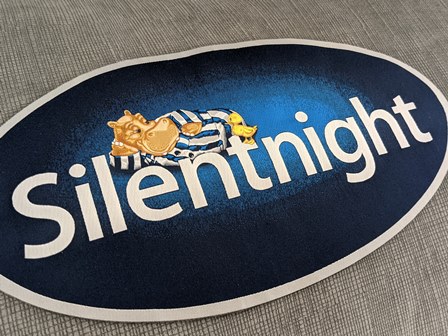
Going for luxury
The luxury end of the market is pretty small with the £800+ market adding up to only one fifth of mattresses sold in the UK. The data mixes together different sizes, but it gives us a good starting point because 70% of mattresses sold in the UK are either double or king size. That includes the DreamCloud mattress, the Hypnos Luxury Wool No. 1/No.2 and the Vispring Plymouth from our list.
The study by the National Bed Federation found that 0% of the 500 people questioned had spent more than £2000 on their last mattress. I’ve often suspected that this end of the market is tiny and this would appear to support that. We bundled together a couple of categories to make the pie chart neater.

As this chart shows, only about one in five mattresses costs £800+
Value for money?
There is a good argument that you get what you pay for with a mattress. Academics managed to prove this point with a study in 1999 where hotel guests were given either a cheaper, mid-priced or more expensive mattress. None of them knew they were taking part in an experiment. They found that ‘the three qualities of the mattresses correlated significantly and positively with the perceived quality of sleep’ (see Enck, Walten and Traue, 1999).
My advice would be to ignore the ‘original’ or the ‘RRP’ of a mattress. Instead, look at what you are paying on the day versus the specification. I have found there to be a significant difference in specification and quality between a £100-£200 double mattress and a £200-£300 mattress. The difference in specification between a £600 mattress and a £700 mattress will likely be less significant.
What type of construction do you want? Springs or foam?
Have a think about what material you want your mattress to be made from.
The very cheapest mattresses tend to be either very thin layers of foam or are made from ‘open coil’ springs. We haven’t included any of those on our top 10, although the Silentnight 3 Zone mattress is relatively thin at 18cm deep.
Some mattress brands have experimented with innovative designs which combine the two. For example, the Dormeo Octaspring uses springs made from foam.
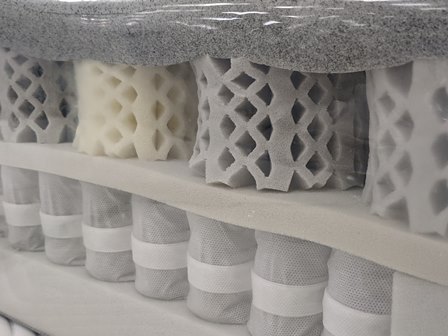
Avoid open coil and thin foam mattresses
I would try to avoid open coil springs as they don’t offer very good stability. Heavier people will find they can feel the slats on a bed with a very thin foam mattress. A strong reason to avoid open coil mattresses is the link between deep sleep and stability. Evidence of this was found by Shen, Chen et al in 2012.
One compelling argument for a budget sprung mattress is that open coil mattresses are easier to recycle than pocket sprung mattresses.
This creates a bit of a conundrum for environment conscious shoppers. Would you like to have the better sleep offered by a pocket sprung mattress? Or would you rather not leave a mattress sized problem for recyclers to deal with when you dispose of your mattress? Some people compromise by getting a pocket sprung mattress for daily use and an open coil mattress for a rarely used spare room. I guess it depends how long you want your guests to stay for…
Assuming you are choosing between pocket sprung and memory foam mattresses, there are various pros and cons which you’ll need to weigh up.
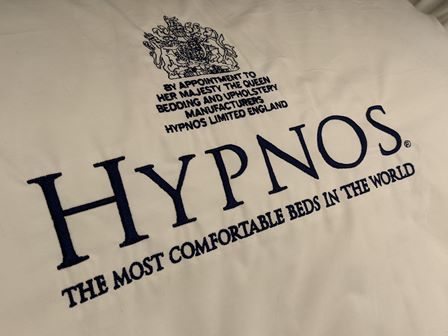
Breathability and warmth – a heated issue
A hot topic is the question of whether memory foam makes you feel warmer than a pocket sprung mattress. I’ve read a huge number of customer reviews to try and reach an opinion. I would say that a good proportion of people do find that memory foam makes them feel too warm.
However, it’s certainly not everyone’s experience and the academic research is a bit lacking.
We can gain some insight by using Amazon’s tool which highlights key words frequently mentioned in reviews.
Red hot reviews
At the time of writing, the Emma Mattress had received about 3000 reviews on Amazon. However, phrases related to heat, overheating or warmth aren’t included as any of the frequently mentioned phrases.

Notably, the Emma Mattress uses a slightly different design to some other memory foam mattress. It uses the layer of foam towards the middle of the mattress. A higher response layer is on top, meaning that it bounces back quicker. This is a design technique which partially aims to reduce the heat issue associated with memory foam.
Further insight from reviews
It’s a similar story with the Silentnight 3 Zone memory foam mattress. This mattresses uses a more conventional memory foam design and has had 8000+ reviews on Amazon.

Screenshot from Amazon showing key words from 8000+ reviews of the Silentnight 3 Zone Mattress
You’ll see that heat isn’t regularly raised as an issue. Notably, the ‘chemical smell’ which you get with some memory foam mattresses is mentioned. This tends to disappear quite soon and is usually called ‘off gassing’.
Following the science
Academic papers on the topic of mattress warmth are surprisingly scarce.
The work of Chiba, Yabi et al in 2018 is interesting. They found a difference in temperature between people using foam toppers which bounce back quickly (‘high response’) versus memory foam material which bounced back slowly (‘low response’). The people using the memory foam material were notably warmer during the night.
That study didn’t compare springs and foam but it does still provide some insight about how foam behaves when you are asleep.
Feeling supported, stable and comfortable on your mattress
Support and comfort are two key areas which you need to consider when weighing up whether a memory foam, pocket spring mattress or hybrid mattress is best for you.
The first thing to say is that a good quality memory foam, pocket spring mattress or hybrid mattress all have the potential to offer a high level of support and comfort. The UK’s Sleep Council says that ‘a supportive and comfortable mattress is the best option – it doesn’t matter what type of construction it is’.
The academic research gives a mixed picture. I would say that overall there are more positive noises towards memory foam for its ability to offer consistent levels of support.
Academic support for memory foam
A study by Gunningberg, Lindholm, Carlsson and Sjödén appears to be an endorsement for memory foam mattresses. The Nectar Sleep Memory Foam mattress and the Silentnight 3 Zone are memory foam models in our top 10.
The study showed off memory foam’s ability to spread out pressure when used in a hospital. However, the theory of reducing pressure on one part of your body can probably be applied to the home. Further endorsement comes from the UK charity Arthritis UK. They say that ‘many people’ with arthritis find a memory foam mattress ‘helpful’. It adds to the evidence that a good memory foam mattress is supportive, whether or not you have that condition.
Further praise for memory foam mattresses’ ability to give you a good night sleep came from Hou and Zhang’s research. The detail of their study is important. They found there was some difference in how well people responded to memory foam based on their age. The oldest participants in the study had a more lukewarm reaction to memory foam than the younger and middle aged participants. See ‘The Influence of Mattress Material on Sleeping Comfort of Different Age’, published in 2020.
It also highlighted some differences in how people responded to memory foam based on their normal sleeping position. Most age groups preferred memory foam in any sleeping position. However, some of the older people in the trial didn’t get on well with memory foam whilst sleeping on their back.
A bounce-back victory for springs
Research by Wang, Zhou et al found different results. They compared three mattresses including a ‘sponge’ mattress and a sprung mattress for an academic trial in 2009. 30 people took part in the trial, aged from 28 to 52. The conclusion was praise for the sprung mattress which they found led to ‘better sleep’. However, this study only had limited relevance to the debate as the competing mattresses were of differing firmness levels. It’s hard to say whether it was the material or the tension which gave the victory to the sprung mattress.
Firm opinions – which is the best mattress for you?
Our top 10 mattresses deliberately includes a range of firmness levels. Firmness is key to comfort and good sleep and shouldn’t be an afterthought. Try the Silentnight 3 Zone mattress at the budget end if you’re after a softer mattress. The Silentnight Deluxe Box Top Mirapocket 2000 Limited Edition Mattress is another softer option which gets an honourable mention.
At the firmer end of the scale, your options include the Silentnight Classic 1200 which is medium/firm.
Some like it soft
Broadly speaking, lighter people need softer mattresses than heavier people. People who sleep on their side need softer mattresses than people who sleep on their backs.
Advice on mattress firmness from manufacturers can be a little inconsistent. Let’s attempt to stick with the scientific research which has been published.
The science of mattress firmness
Ancuelle, Zamudio et al compared how the ‘sleep quality’ of older people was influenced by either using a ‘medium firm mattress’ or a ‘high firm mattress’.
The result was a victory for the medium firm mattress. It led to a ‘significant shorter’ time to get to sleep (‘sleep onset latency‘). It also led to ‘slightly better’ sleep efficiency (research published in 2015).
Kovacs, Abraira et al found similar results in 2003. They compared firm mattresses with medium-firm mattresses with a group of 300 people with back problems. The final conclusion was that ‘A mattress of medium firmness improves pain and disability among patients with chronic non-specific low-back pain’.
These studies help dispel the myth that a rock solid mattress is what you need to look after your back.
Support is everything when you’re looking for the best mattress
The reason for this is best summarised by Leilnahari, Fatouraee et al in their 2011 paper. They said that ‘there is an incorrect spinal support when people lie in a natural lateral sleep position on a very firm mattress’. They added that ‘only the wide areas of the body are supported, i. e. just the shoulder and pelvis receive good support’. (Lateral position means sleeping on your side).
Of course, the extent to which you sink into a mattress depends on your weight and build. It’s vital that you take that into account when choosing firmness. The best summary I’ve heard is from the UK Sleep Council. They say that ‘Your mattress should be firm enough to support your spine in the correct alignment while conforming to your body’s contours’.
The benefits and pitfalls of warranties and trial periods
Memory foam mattresses typically come with a longer warranty for the price compared to pocket spring mattresses. The full range of Nectar Sleep mattresses come with a ‘forever’ warranty despite being a mid-priced model. That’s matched by the DreamCloud mattress which is a hybrid model which combines springs and foam. The two cheapest mattresses we featured include one foam model and one sprung mattress. They both come with a 5 year warranty.
An average warranty
The overall mean life of a mattress is 7.1 years according to the National Bed Federation’s annual report in 2019.
Shoppers replace about two in five mattresses within five years. A third are somewhere between 6-10 years old when replaced.
Is it flippable?
Another factor to consider is that a lot of pocket sprung mattresses are designed to be flipped over. Nearly all memory foam and hybrid mattresses are single-sided. That’s because of the way they use multiple layers to achieve comfort and support.
There doesn’t seem to be detailed and unbiased research into whether flipping a mattress prolongs its life. However, logic and anecdotal evidence suggests that a mattress will develop fewer dips and sags if you can turn it over. Spinning it round is helpful but doesn’t quite achieve the same thing.
The Silentnight Classic 1200, the Vispring Plymouth and the Happy Beds Majestic can all be turned over.
The beauty of trial periods
Perhaps more significant is the option of a trial period. From our top 10 mattresses, half of them come with trial periods. The other half would either require a trip to a showroom or a risky online purchase. All the mattresses in our top 10 which come with a trial period are either 100% foam or hybrid mattresses. A hybrid mattress is one with layers of foam along with springs.
Don’t feel embarrassed about sending back a mattress with a trial period if you aren’t happy with it. A mattress such as the Nectar Sleep Memory Foam Mattress isn’t available in shops and is made by a brand which hasn’t been around for decades. The company is aware that it’s a bit of a risk for a shopper.
Mattresses which offer returns tend to have good policies in place where mattresses are donated to charity or sold again as discounted ‘refurbished models’. It shouldn’t just end up being sent to landfill. If you’re concerned, ask the company what they do with returned mattresses.
The downside of a trial period
Here’s a word of warning. If the company you’ve bought from goes into administration or bankrupt then making a claim under warranty is complicated. In some cases it might not be possible at all. This guide from Which? is useful. Vispring offers a 30 year warranty but it feels like it’s worth something because the company has been trading for more than a century.
Read the smallprint
Another cautionary note is that some mattress trial periods come with complicated clauses. We have tried to feature those mattresses with a relatively simple setup. However, do have a read of the small print as these things change sometimes. Some of the things to check before you take out a trial period include:
- the minimum length of time that you need to keep the mattress before you can send it back
- whether you need to use a mattress protector during the trial
- whether you can get your money back, or whether you just get the chance to swap the mattress. If so, what happens if you choose a mattress which is cheaper or more expensive than the first one you chose? You’ll pay extra for an upgrade but you might not get your money back if you downgrade.
- will you have to pay a returns delivery fee or is it covered by the seller?
The environmental impact of your mattress
The impact a mattress has on the planet and the affect they might have on you are also worth considering.
This is a contentious area so let’s focus on the academic research and papers which have been published.
It might be the best mattress for you…but is it the best mattress for the planet?
Firstly, there’s the question of the impact on the environment of your new mattress being made.
According to the Furniture Industry Research Association, the production of a double mattress creates an ‘Estimated average carbon footprint’ of 79 kg CO2. This is mostly a result of ‘the carbon impact of raw materials (i.e. foams and fillings, textiles and metals)’. According to CNet, that’s the same as making and using an iPhone X over its life.
The choice of mattress makes a big difference to the carbon footprint. The FIRA report said that it depends largely ‘on the amount and type of foam/filling used with larger amounts of filling leading to higher carbon footprints’. In other words, the depth of your mattress and the type of material affects its carbon footprint.
The same report also highlights that ‘polyester wadding…is estimated to have a carbon impact that is more than double that of cotton based wadding’. You’ll find cotton wadding in a posher sprung mattress such as the Vispring Plymouth. Polyester wadding is used on cheaper sprung mattresses.
However, to further complicate matters it also says that ‘wool textile is estimated to be more carbon intensive than both polyester and cotton wadding’. A mattress such as the Vispring Plymouth mattress uses a combination of wool and cotton, so it is both good news and bad news.
The carbon footprint of memory foam
As for memory foam, the report says that standard ‘polyurethane foam has an estimated lower footprint than that of Visco-elastic foam, by approximately 20% assuming the same weight’. Visco-elastic foam is another name for memory foam.
The conclusion is that a mattress with a thicker layer of memory foam will have a greater carbon footprint than a mattress which is mostly standard foam with a thin layer of memory foam. From our top 10 mattresses, you’ll see that the Ergoflex 5G has a 9cm layer of memory foam and is 25cm in depth whilst the Silentnight 3 Zone mattress only has a 3cm layer of memory foam and a total depth of 18cm. The latter should have a smaller carbon footprint.
Again, there is a payoff for the purchaser. Would you like better support and comfort from a deeper mattress with a thick layer of memory foam? Or would you prefer a thinner mattress without much memory foam which has a smaller carbon footprint?
It is worth asking what mattress manufacturers are doing about their carbon footprint rather than ending up in a guilt-ridden circle of despair.
As mentioned earlier, Nectar Sleep offset their carbon usage to the extent that ‘mattress production is certifiably climate neutral’. The important thing is that you don’t assume that a mattress which sounds ‘natural’ or ‘organic’ will actually have a smaller carbon footprint than one which uses synthetic materials.
A longer lasting mattress is better for the planet
The average mattress lasts for about seven years. That’s according to the National Bed Federation’s Annual Report in 2020.
However, about a third of mattresses are disposed of after less than five years. About one in five mattresses lasts for more than 10 years.
If all other factors are the same then the longer lasting mattress obviously has a smaller environmental impact.
The complication is that it’s hard to say how long a mattress will last for. I’m yet to find brand-by-brand data showing mattress life expectancy.
You can get a rough indication of longevity by looking at a mattress’ warranty length.
Memory foam mattresses tend to come with slightly longer warranties than pocket sprung mattresses when you compare similar priced models. So, you might assume a memory foam mattress would last longer and have less environmental impact as a result.
However, there are problems with that assumption.
For example, there is intense competition between memory foam mattress brands to out-do each other on warranty length. I suspect that some brands are assuming that most people won’t put in a claim after many years.
Others have been trading for less time than the length of their warranty. As a result, it’s hard to say how long their mattresses will last for.
Confusion around longevity of mattresses
There’s also confusion around a mattress’ warranty versus when you should replace it. The National Bed Federation suggests you should change your mattress about once every seven years. Yet, high quality brands such as Sleepeezee and Hypnos offer 10 year warranties on most mattresses.
So is the mattress designed to last 10 years or 7 years?
It’s worth noting that the National Bed Federation says this may not ‘this may not always be the ideal time’ to change your mattress. In some cases it will be longer. The NBF is the trade association of the UK’s bed manufacturers.
So which type of mattress will last longer?
I don’t have a definite answer about which brand of mattress will last longest (e.g. Hypnos v Simba v Silentnight). I also don’t have a definite answer about which type of mattress will last longer (e.g. memory foam v pocket springs).
Several websites say that memory foam is longer lasting. However, those claims don’t seem to be supported by detailed research or data.
Is the mattress good for your health?
Let’s move on to another related area in this best mattress UK guide – the question of the health of different types of mattress material.
A number of studies have looked at the Volatile Organic Compounds which are released by foam mattresses.
In one study by Hillier, Schupp and Carney, researchers looked at ‘flexible polyurethane foam mattresses’. They found ‘No evidence of any human health risk was identified from the ‘worst-case’ exposure model employed’ (published in 2003). Meanwhile, a paper in 2019 by Oz, Merav et al looked at eight different polyurethane mattresses. They were placed ‘under different temperature, relative humidity, and CO2 concentrations’. They concluded that ‘Under sleeping conditions VOC emissions increased significantly’.
Dust mites and your mattress
Finally, let’s look at the question of which of our mattresses will be best for you if you are allergic to dust mites. You may have heard that synthetic materials are better for keeping away dust mites. However, the science raises questions about that.
Work by van den Bemt and de Vries is worth a read as it found there were lower levels of allergen on ‘a cotton upper layer of the mattress compared with a layer of synthetic material’. Their study involved 168 surveys carried out in the Netherlands. See ‘Influence of mattress characteristics on house dust mite allergen concentration’ which was published in 2006.
Further research suggests that the most important factor is to use a cover which is impermeable to dust mites. Van den Bemt and van Knapen found that ‘impermeable covers significantly decreased the level of house dust mite allergens‘ in 2004). This approach is supported by Allergy UK which has a selection of anti allergy bedding which it has tested.
What will happen to my old mattress?
One factor that you might have in mind when buying a new mattress is what will happen to the one you’ve finished with. Every day in the UK about 22,000 mattresses are disposed of according to the Furniture Industry Research Association. That’s a huge amount of waste.
Mattress recycling rates
A report by the National Bed Federation in 2019 covered this in some depth. They put the current rate of recycling at ‘around the 20% mark’. The good news is that ‘overall mattress recycling is increasing’. There are ambitions to increase that to 75% by 2028.
You might assume that mattresses made from pocket springs and natural materials are easier to recycle than mattresses made from foam and synthetic fibres. It’s not quite as simple as that.
The recycling challenge of sprung mattresses
Back in 2005, most mattresses sold in the UK were ‘open coil’ sprung mattresses. That means you were supported by a ‘continuous’ piece of metal which was twisted into a series of springs. Since then, more of us have switched to pocket spring mattresses which are more supportive and stable. That’s good news for our quality of sleep but the National Bed Federation says that this is ‘a challenge’ for mattress recyclers.
Companies have to somehow remove hundreds or thousands of springs from a mattress rather than one massive spring. In some cases this involves ‘manually tak(ing) the springs out of the pockets’ which sounds about as much fun as a trip to the dentist.
Once the metal is removed, it is one of the ‘most valuable materials recovered from mattresses, on a weight basis’. The other material which has high value is ‘polyester wadding’ which is a synthetic material used to add comfort. It often ends up in pet beds according to the National Bed Federation. That sort of material is mostly used on cheaper and mid-priced mattresses. So, if your mattress contains those then there would seem to be a higher chance of it being recycled than other mattress materials.
Recycling foam, coir and latex mattresses
Meanwhile, foam from old mattresses does sometimes have a purpose, such as for carpet underlay. Coir – which is a brown material from coconuts – can be turned into lining for hanging baskets. Latex, which is a natural material which is seen as a sustainable material ‘has no second-life applications other than energy recovery’ according to the National Bed Federation.
Posh natural fibres that you get on expensive mattresses (cashmere, mohair etc) do have value for recycling. Unfortunately, the National Bed Federation’s report notes that ‘some small-scale operators have difficulties accessing all these markets due to the low volumes they have to trade.‘
Last updated: 2024. Review scores, prices and other details correct at the time of writing

